
Journal of Clinical Trials
Open Access
ISSN: 2167-0870

ISSN: 2167-0870
Commentary - (2025)Volume 15, Issue 5
The global burden of COVID-19 has underscored the importance of early therapeutic interventions to prevent disease progression and hospitalization. With the advent of oral antivirals, there is renewed interest in outpatient treatment options for patients diagnosed in the early phase of infection. Several oral agents have received emergency or conditional authorization, but comparative data between different antiviral regimens remain limited. This multi-center randomized trial aimed to evaluate the efficacy and safety of three oral antiviral agents in non-hospitalized adults with confirmed SARS-CoV-2 infection who were at increased risk for severe disease.
The study was conducted across 15 urban and semi-urban hospitals during a period of high community transmission. A total of 1,200 adults aged 18 and above were enrolled within five days of symptom onset and confirmed positive through RT-PCR testing. Eligible participants had at least one risk factor for severe disease, such as age above 60, obesity, diabetes, cardiovascular disease, or chronic respiratory illness. Participants were randomized into three treatment arms: Group A received nirmatrelvir-ritonavir, Group B received molnupiravir and Group C received favipiravir. Each drug was administered according to its respective protocol for a duration of five days.
The primary endpoint was the proportion of participants with sustained symptom resolution by day 10. Secondary endpoints included hospitalization rates, need for supplemental oxygen, duration of fever, viral load reduction by day 5 and incidence of drug-related adverse events. Patients were monitored through teleconsultation and scheduled in-person assessments on days 3, 5, 10 and 28.
At day 10, 81% of patients in Group A reported complete symptom resolution, compared to 70% in Group B and 64% in Group C. The difference between Group A and the other two groups was statistically significant. Median time to fever resolution was shortest in Group A (2.1 days), followed by Group B (3.3 days) and Group C (3.6 days). Reduction in viral load on nasopharyngeal swab testing was also greatest in Group A by day 5, indicating faster virological response.
Hospitalization occurred in 3.5% of patients in Group A, 6.1% in Group B and 8.8% in Group C. No deaths were reported in any group and all hospitalizations were managed without mechanical ventilation. Patients in Group A had shorter durations of hospital stay compared to those in Groups B and C.
Adverse events were mostly mild and included nausea, metallic taste, diarrhea and transient elevations in liver enzymes. The incidence of adverse events was similar across the three groups, though Group C had slightly more reports of gastrointestinal discomfort. No treatment discontinuations were required due to adverse effects.
Patient satisfaction was higher in Group A, with most individuals reporting rapid relief of symptoms and ease of adherence. In contrast, some participants in Group C expressed concerns about the higher number of tablets and longer duration of perceived recovery. Adherence rates exceeded 95% in all groups, aided by daily follow-up and medication counseling.
This study also explored treatment impact on transmission within households. Among participants with household contacts tested during follow-up, secondary attack rates were lower in Group A (19%) compared to Group B (27%) and Group C (30%). Although not a primary outcome, this finding suggests a potential reduction in infectiousness through faster viral suppression.
The selection of oral antivirals for COVID-19 treatment requires consideration of multiple factors including efficacy, safety, availability and cost. While nirmatrelvir-ritonavir showed the most favorable outcomes, access to this agent may be limited in some regions due to supply constraints or drug interactions. Molnupiravir and favipiravir, although less effective, remained beneficial compared to no treatment, particularly when initiated early.
Logistical challenges in drug distribution and patient identification in the early window of infection remain significant barriers to implementation. Ensuring access to diagnostic testing and prompt medical evaluation is essential to enable early antiviral use. In this trial, patients who began treatment within three days of symptom onset experienced better outcomes compared to those starting on day four or five, highlighting the time-sensitive nature of intervention.
In conclusion, among the three oral antivirals evaluated in this randomized trial, nirmatrelvir-ritonavir was associated with the fastest symptom resolution, greatest viral load reduction and lowest hospitalization rates in adults with mild-to-moderate COVID-19. While all three agents provided measurable benefit when initiated early, differences in efficacy and patient experience were notable. These findings support the prioritization of antiviral therapy for at-risk outpatients and the need for timely diagnosis and access. Ongoing surveillance for viral resistance and continued post-market data collection will be important in guiding future treatment protocols.
Citation: Boer C (2025). Comparative Evaluation of Oral Antivirals for Early Treatment of COVID-19: A Multi-Center Trial. J Clin Trials. 15:600.
Received: 30-Jun-2025, Manuscript No. JCTR-25-37921; Editor assigned: 03-Jul-2025, Pre QC No. JCTR-25-37921 (PQ); Reviewed: 17-Jul-2025, QC No. JCTR-25-37921; Revised: 24-Jul-2025, Manuscript No. JCTR-25-37921 (R); Published: 31-Jul-2025 , DOI: 10.35248/2167-0870.25.15.600
Copyright: © 2025 Boer C. This is an open-access article distributed under the terms of the Creative Commons Attribution License, which permits unrestricted use, distribution and reproduction in any medium, provided the original author and source are credited.